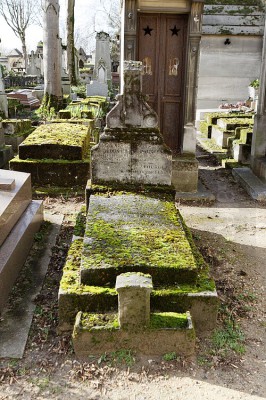
Frank William Boggs, known professionally as Frank Will, stands as a notable figure in early to mid-20th century French art. Born at the turn of the century in 1900 and passing away in 1951, his life spanned a period of immense artistic ferment and social change in France, particularly in Paris. Though perhaps less globally renowned than some of his avant-garde contemporaries, Will carved a distinct niche for himself with his evocative depictions of urban landscapes, bustling harbors, and market scenes, primarily rendered in watercolor and oil paint. His work offers a sensitive and skilled portrayal of the atmosphere and daily life of his time, preserving moments of French history on paper and canvas.
As the son of an American artist father and a French mother, Will embodied a blend of cultural influences, though his artistic identity remained firmly rooted in the French tradition, especially the vibrant milieu of Paris. His legacy is tied to his technical proficiency, his keen observational eye, and his connection to the artistic communities, particularly that of Montmartre. This exploration delves into the life, style, key works, and artistic context of Frank Will, shedding light on his contribution to the rich tapestry of 20th-century French painting.
Early Life and Artistic Formation
Frank William Boggs was born in 1900 in Nanterre, located in the Seine department (now Hauts-de-Seine) near Paris, not Seine-et-Oise as sometimes mistakenly cited. His artistic inclinations were perhaps preordained, being the son of the respected American expatriate painter, Frank Myers Boggs (1855-1926). The elder Boggs was known for his atmospheric marine paintings and cityscapes, particularly views of Paris and various port towns, executed often in watercolor with a fluid, impressionistic touch. He had established himself within the French art scene, providing young Frank Will with direct exposure to the life of a working artist from an early age.
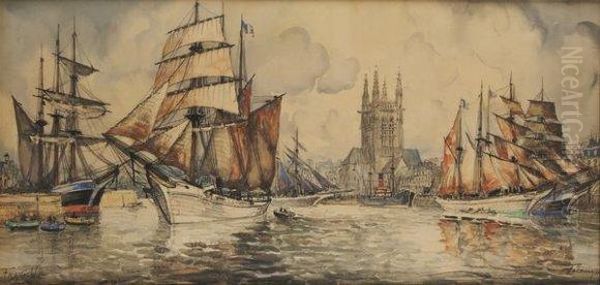
Under his father's tutelage, Frank Will began honing his skills. Early artistic development took place in his father's studio in Clignancourt, a district on the edge of Montmartre. This environment undoubtedly nurtured his burgeoning passion for drawing and painting. Initially, Will pursued studies in architecture, a field demanding precision and structural understanding. However, the allure of the fine arts proved stronger, leading him to abandon architecture and dedicate himself entirely to painting and drawing, following in his father's footsteps yet developing his own distinct voice.
The guidance of Frank Myers Boggs was crucial, providing not just technical instruction but also an entry point into the Parisian art world. The younger Boggs, adopting the professional name Frank Will, absorbed the lessons of observation, composition, and medium handling, particularly the nuances of watercolor, a medium favored by his father. This foundational period set the stage for a career focused on capturing the visual essence of his surroundings with both accuracy and artistic flair.
The Parisian Scene and Montmartre
Frank Will's artistic identity is inextricably linked to Paris, the city he depicted frequently and with great affection. He became deeply associated with the School of Montmartre (École de Montmartre), not a formal institution but rather a loose collective of artists living and working in the famous hilltop neighborhood known for its bohemian spirit and artistic legacy. During the early 20th century, Montmartre was a melting pot of creativity, home to studios, cabarets, and a vibrant street life that provided endless inspiration.
Within this milieu, Frank Will developed significant connections. He formed a close friendship with Gen Paul (1895-1975), another prominent Montmartre painter known for his dynamic, expressionistic style and depictions of Parisian life, particularly horse races and street scenes. This friendship likely provided mutual support and artistic exchange. Will was also associated with Marcel Leprin (1891-1933), another key figure of the Montmartre school celebrated for his atmospheric cityscapes, often imbued with a melancholic sensitivity.
The influence of Montmartre is palpable in Will's work. He captured its iconic landmarks, such as the Sacré-Cœur Basilica and the Moulin de la Galette, but also its quieter streets, bustling markets, and the unique character of its architecture. His connection to this specific locale places him alongside other artists who chronicled the area, such as Maurice Utrillo (1883-1955), famous for his starkly beautiful paintings of Montmartre streets, often painted from memory or postcards, and Utrillo's mother, Suzanne Valadon (1865-1938), a formidable artist in her own right who also depicted the local scene. Frank Will's contribution offers a perspective grounded in direct observation and a fluid, often lively technique.
Artistic Style and Techniques
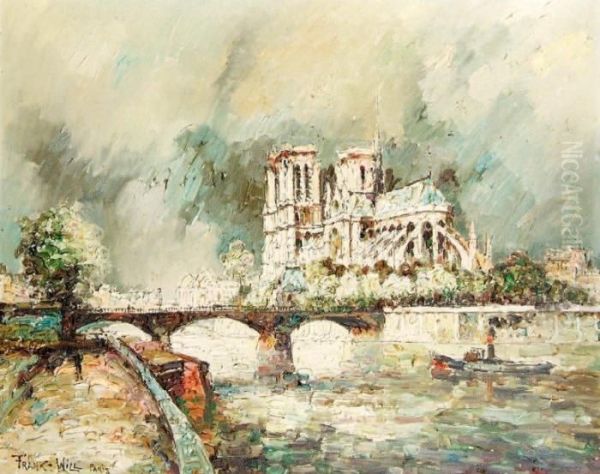
Frank Will primarily worked in watercolor and oil paint, often demonstrating a remarkable facility with both mediums. His watercolors are particularly noteworthy, characterized by a confident handling of washes, precise linework, and an ability to capture light and atmosphere effectively. He frequently combined watercolor with graphite or black pencil outlines, a technique that allowed him to define forms clearly while maintaining the transparency and luminosity of the watercolor itself. This hybrid approach lent structure and detail to his compositions, particularly visible in architectural elements and the rigging of ships in his harbor scenes.
His style often shows affinities with Post-Impressionism in its attention to light and color, yet it also incorporates elements that lean towards Expressionism, especially in the energy and dynamism found in some of his street scenes or market depictions. His brushwork could range from meticulous and descriptive to broader and more gestural, depending on the subject and desired effect. He wasn't strictly aligned with the major avant-garde movements like Cubism, spearheaded by Pablo Picasso (1881-1973) and Georges Braque (1882-1963), or Fauvism, championed by Henri Matisse (1869-1954) and André Derain (1880-1954). Instead, Will operated within a more representational framework, focusing on capturing the visual character of specific places.
Compared to contemporaries like Raoul Dufy (1877-1953), known for his light, airy watercolors and calligraphic lines, Will's work often feels more grounded and substantial, with a greater emphasis on structure and detail. While Dufy celebrated the ephemeral joys of leisure and society, Will often focused on the working aspects of the city and port life. Occasionally, Will explored a freer, more imaginative style, as seen in rare works described as "Bacchanales," where he reportedly employed bolder colors and a more deconstructivist approach, stepping away from his usual disciplined observation. This suggests an artist capable of stylistic variation, though his reputation rests primarily on his topographical views.
Key Themes and Subjects
Thematically, Frank Will's oeuvre revolves around the landscapes and human activity of France, with a particular emphasis on Paris and coastal towns. His Parisian scenes are numerous and varied, capturing the city's iconic monuments as well as its everyday life. He painted Notre Dame Cathedral from the quays (Notre-Dame vue des quais), the bustling atmosphere around landmarks like the Opéra Garnier, the bridges spanning the Seine, and the characteristic streets and squares of different arrondissements, especially his beloved Montmartre, including views of the Moulin de la Galette.
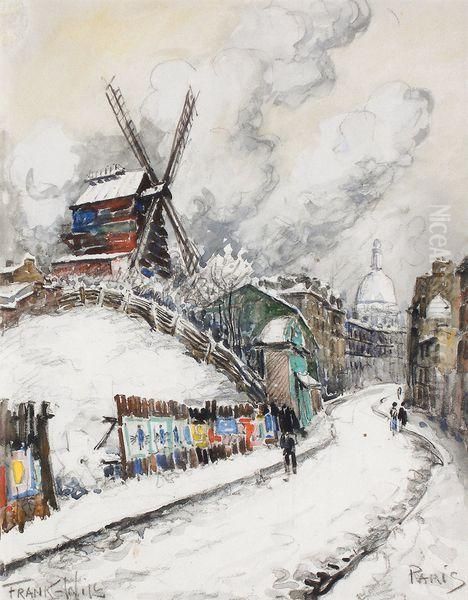
Harbor scenes form another significant part of his work. Inspired perhaps by his father's marine paintings, Frank Will traveled to coastal towns in Normandy and Brittany, producing vivid depictions of ports like Fécamp, Dieppe, and Marseille. His painting Fecamp Port is a prime example, showcasing tall ships docked in the harbor, rendered with attention to architectural detail and the specific atmosphere of a working port. Similarly, his views of Marseille, such as Port de Marseille et Notre Dame de la Garde, capture the light and activity of the Mediterranean coast.
Beyond Paris and the ports, Will also painted other French locations. Works like Village de Goupilles, Caudebec, la filature de coton (Caudebec, the Cotton Mill), and Moret Sur Loing, La Porte Medievale demonstrate his interest in rural villages, industrial landscapes, and historical architecture across different regions of France. He even ventured occasionally beyond French borders, as evidenced by paintings like Londres, Tower Bridge (London, Tower Bridge), showcasing his ability to apply his observational skills to international subjects. Through these varied themes, Will acted as a visual chronicler, documenting the appearance and spirit of places during the first half of the 20th century.
Notable Works Explored
Several specific works stand out in Frank Will's production, illustrating his typical subjects and stylistic approaches.
Fecamp Port: Often dated to the 1920s or 1930s, this watercolor, sometimes enhanced with pencil, is a quintessential example of his harbor scenes. It depicts the bustling port of Fécamp in Normandy, likely showing fishing vessels or coastal traders with their tall masts dominating the composition. Will masterfully captures the reflections in the water, the textures of the quayside buildings, and the intricate details of the ships' rigging. The work conveys the robust atmosphere of a working maritime community and showcases his skill in combining detailed drawing with fluid watercolor washes.
Notre-Dame vue des quais: This subject, revisited by countless artists, receives a fresh treatment in Will's hands. Typically painted from the Left Bank, his views capture the imposing Gothic architecture of the cathedral, often framed by the Seine River, barges, and the stone embankments (quais). He skillfully renders the play of light on the stone facade and the surrounding water, evoking the timeless grandeur of the monument within its living, contemporary Parisian context.
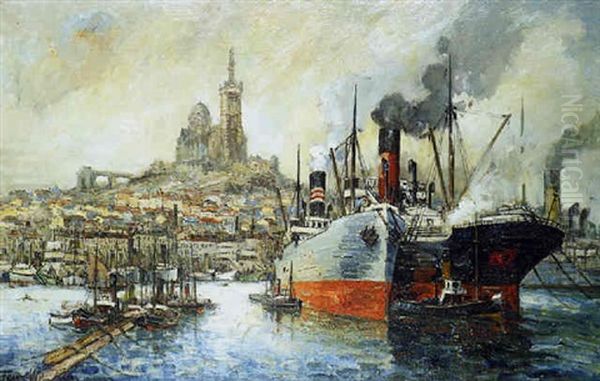
Montmartre, Le Moulin de la Galette: This famous Montmartre landmark, a windmill converted into a popular dance hall and restaurant, was a recurring subject for artists like Renoir, Van Gogh, and Utrillo. Frank Will's interpretations capture the structure itself, often situated within the characteristic streetscape of Montmartre. Depending on the specific work, he might emphasize the lively atmosphere associated with the venue or present a quieter, more architectural study. (Note: Some sources mistakenly refer to this as a "Butter Market," which is incorrect; it's the famous windmill and entertainment venue).
Port de Marseille et Notre Dame de la Garde: Representing his work on the Mediterranean coast, this subject typically features the vibrant Old Port of Marseille, filled with boats, under the watchful gaze of the Basilica of Notre Dame de la Garde perched on the hill above. Will captures the bright southern light and the lively maritime activity characteristic of France's largest port city.
Cathédrale de Reims (Reims Cathedral, 1929): An oil painting depicting another major French Gothic cathedral, this work shows Will's ability to handle architectural subjects with solidity and presence in oil, capturing the intricate facade and monumental scale of the building.
Londres, Tower Bridge: This work demonstrates his occasional foray into international subjects. Applying his characteristic style, he depicts the iconic London landmark, likely focusing on its structure and its setting on the River Thames, showcasing his consistent interest in architectural and waterside scenes regardless of location.
These examples highlight Frank Will's dedication to specific locations, his technical versatility across watercolor and oil, and his ability to convey both the grandeur of monuments and the atmosphere of everyday places.
Exhibitions and Recognition
During his lifetime, Frank Will achieved a degree of recognition within the Parisian art world, exhibiting his work at several prominent galleries. In the 1920s, his paintings were shown at the prestigious Galerie Georges Petit, a gallery known for exhibiting Impressionist and Post-Impressionist masters, including Claude Monet and Auguste Rodin. This association suggests that Will's work found favor within established art circles early in his career.
Later, in the 1930s, he exhibited at the Galerie Hector Brame, and subsequently at the Galerie Henri Bureau. Consistent exhibition opportunities at respected Parisian galleries indicate a steady professional career and a market for his work. Furthermore, his art was included in various group exhibitions, both in France and potentially internationally, contributing to his visibility among collectors and fellow artists.
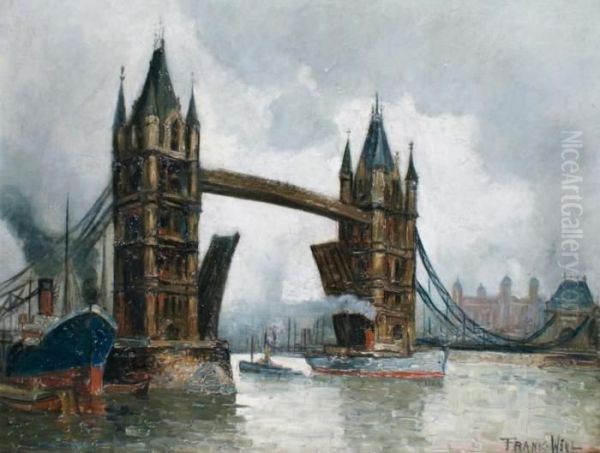
While he may not have reached the level of fame enjoyed by the leading figures of modernism like Picasso or Matisse, or even some of his Montmartre associates like Utrillo, Frank Will was a respected working artist. His connection to the School of Montmartre and his friendships with artists like Gen Paul placed him firmly within a recognized artistic community. The inclusion of his works in gallery inventories and group shows confirms his active participation in the art scene of his time. Posthumous recognition has continued through gallery retrospectives and the consistent appearance of his works in auctions.
Market Presence and Legacy
Frank Will's works continue to circulate in the art market, appearing regularly at auctions in France and internationally. Prices for his paintings and watercolors vary depending on size, medium, subject matter, condition, and provenance. Watercolors, particularly his desirable Parisian views or lively harbor scenes, can fetch prices ranging from several hundred to several thousand Euros. His oil paintings generally command higher prices.
Specific auction results mentioned in various sources include Notre-Dame vue des quais selling for around €600, Fecamp Port achieving prices between €400 and potentially up to €3000 in different sales, Paris, l'église Saint-Denis estimated or sold in the €2000-€2500 range, and a significant work like Londres, Tower Bridge reaching estimates of €5000-€6000. These figures indicate a stable market interest, positioning his work as accessible to collectors yet recognized for its quality and historical value. Major auction houses and specialized galleries dealing in 20th-century French art frequently handle his pieces.
His legacy rests on his contribution as a skilled and sensitive chronicler of early to mid-20th century France. He captured the specific character of Paris, its evolving neighborhoods like Montmartre, and the enduring life of its ports and provinces. His technical proficiency, especially in watercolor combined with pencil, allowed for both detailed representation and atmospheric effect. As the son of Frank Myers Boggs, he represents a continuation of a family artistic tradition, yet he established his own distinct identity. He remains an important figure within the context of the School of Montmartre and the broader tradition of French figurative painting in his era, valued for his authentic and evocative depictions of a bygone time.
Wider Context and Contemporaries
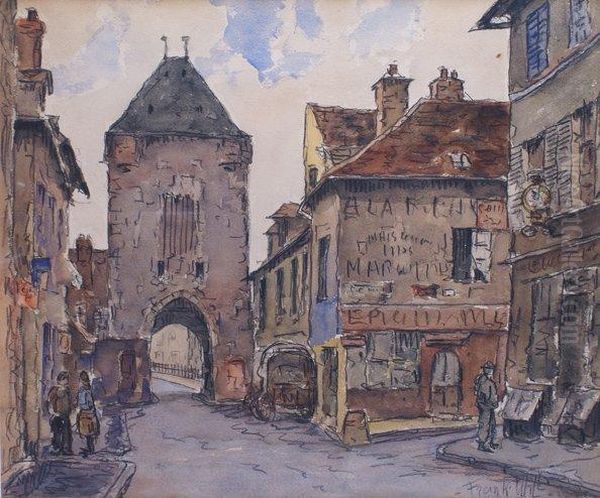
To fully appreciate Frank Will's position, it's essential to consider the broader artistic landscape of his time. He worked during a period of radical innovation in Paris, the undisputed center of the art world. While Will pursued a largely representational path, the city was simultaneously witnessing the consolidation of Cubism (Picasso, Braque), the lingering influence of Fauvism (Matisse, Derain, Maurice de Vlaminck), the rise of Surrealism led by André Breton, and the diverse activities of the international artists comprising the School of Paris (École de Paris).
This latter group, centered in Montparnasse rather than Montmartre, included figures like Amedeo Modigliani (1884-1920) with his distinctive portraits, Chaïm Soutine (1893-1943) with his intensely expressive landscapes and still lifes, and Marc Chagall (1887-1985) with his dreamlike, poetic imagery. These artists pushed the boundaries of representation, color, and form in ways fundamentally different from Will's approach.
Even within the realm of depicting Paris and French life, there were diverse styles. Albert Marquet (1875-1947), initially associated with the Fauves, developed a more subdued, tonal style, often painting views of the Seine and ports with a quiet lyricism. Raoul Dufy, mentioned earlier, offered a much lighter, decorative, and optimistic vision of French scenes. Maurice Utrillo, his Montmartre neighbor, conveyed a unique sense of solitude and structure in his cityscapes.
Frank Will's work, therefore, exists alongside these varied artistic currents. He was not an avant-garde innovator but rather a dedicated practitioner of landscape and cityscape painting, upholding traditions of observation and skilled rendering while infusing his work with the atmosphere of his time. His connection to Montmartre places him within a specific, geographically defined artistic community that valued capturing the local scene, albeit with different individual styles ranging from Utrillo's starkness to Gen Paul's dynamism to Will's detailed and atmospheric realism. His art provides a valuable counterpoint to the more radical experiments occurring elsewhere in Paris, offering a grounded, visually accessible record of French life.
Conclusion
Frank Will (Frank William Boggs) remains a significant, if sometimes overlooked, figure in 20th-century French art. His extensive body of work, primarily watercolors and oils, serves as a rich visual archive of Paris, French ports, and provincial towns during a period of transition. Guided initially by his artist father, Frank Myers Boggs, he developed a distinct style characterized by skilled draftsmanship, atmospheric sensitivity, and a keen eye for detail.
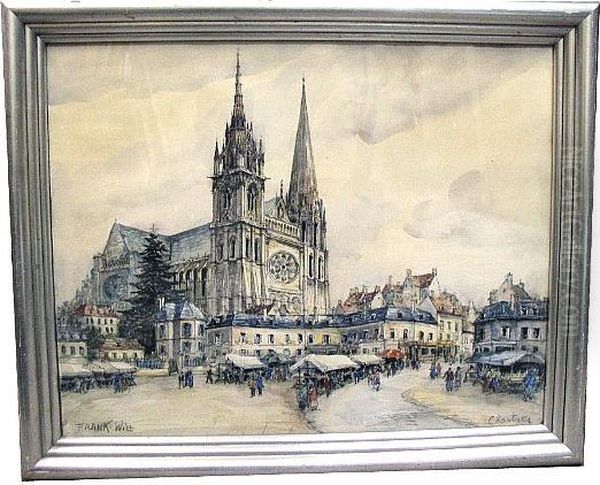
His close association with the School of Montmartre and artists like Gen Paul situates him within a key artistic community known for its bohemian spirit and focus on local subject matter. While not an avant-garde revolutionary, Will excelled within his chosen representational framework, creating works that are both aesthetically pleasing and historically valuable. His paintings of Notre Dame, the Seine, Fécamp harbor, and the streets of Montmartre continue to resonate with viewers, offering evocative glimpses into the past.
Through consistent exhibitions during his lifetime and a continued presence in the art market today, Frank Will's legacy endures. He stands as a testament to the enduring appeal of well-executed figurative painting and the importance of artists who dedicate themselves to chronicling the world around them with honesty and skill. His work invites us to see early 20th-century France through his eyes, appreciating the beauty and character he found in its cities, harbors, and landscapes.